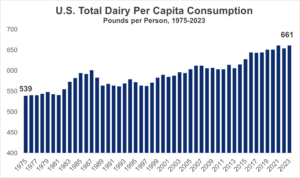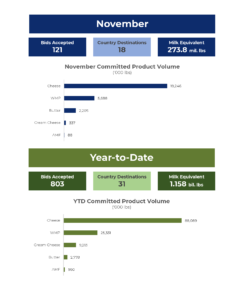NMPF is analyzing the results of the 2024 elections, building new relationships and strengthening old ones as business-as-usual in Washington promises to shift next year with Republican control of the White House and both houses of Congress.
In preparation for this “trifecta” next year, House and Senate Republicans elected their leadership teams immediately following the November elections. House Republicans voted to keep in place Speaker Mike Johnson, R-LA, Majority Leader Steve Scalise, R-LA, and Majority Whip Tom Emmer, R-MN, while electing Representative Lisa McClain, R-MI, as Republican Conference Chair.
Representatives Emmer and McClain both represent sizable dairy footprints. In the Senate, Republicans elected Senator John Thune, R-SD, a longtime dairy ally and Senate Agriculture Committee member, to serve as their Majority Leader next year. Sens. John Barrasso, R-WY, Tom Cotton, R-AR, and Shelley Moore Capito, R-WV, were elected to the other top leadership spots of Majority Whip, Republican Conference Chair, and Republican Policy Committee Chair, respectively.
House Republicans in December are likely to work with President Biden and Senate Democrats to extend several expiring laws on a short-term basis so that they can tackle them next year with complete control of the nation’s capital. Congress also is on track to pass another one-year extension of the 2018 farm bill before adjourning.
This year’s House farm bill and Senate frameworks included numerous dairy priorities, such as requiring USDA to conduct mandatory manufacturing cost surveys every two years, prioritizing the protection of common food names in trade discussions, and allowing schools to serve nutrient dense whole milk. Should a new farm bill not be passed this month, NMPF will once again advocate for a new farm bill next year that meets dairy’s needs. However, an extension at least would ensure that the Dairy Margin Coverage program continues without disruption.
Congress also is likely to extend government funding on a short-term basis, possibly until March. The House and Senate 2025 agriculture funding bills included several NMPF-backed provisions, including House language to reverse the reduction in the maximum monthly milk allotment in USDA’s final foods package rule for the Special Supplemental Nutrition Program for Women, Infants, and Children and Senate language mirroring the Innovative FEED Act to allow the Food and Drug Administration to review animal feed additives in a more efficient manner.
While a short-term funding extension will require the new Congress to complete the full-year 2025 bills, the bills drafted this year will likely serve as the starting point for final negotiations next year.
The 119th Congress that convenes in January will have a full plate that extends well beyond finishing this year’s business. An extension of the debt limit, the federal government’s borrowing authority, will come due in the first quarter of the year. Then, with full control of Washington, Republicans are expected to turn their attention to extending the expiring provisions of the Tax Cuts and Jobs Act of 2017, one of President-elect Trump’s signature accomplishments from his first term.
NMPF will urge Congress to continue several pieces of the 2017 law, including the Section 199A domestic manufacturing tax deduction that allows agricultural cooperatives to pass the proceeds directly back to their farmer-owners. Congress is likely to complete this process using the tool known as budget reconciliation, which allows for the consideration of certain taxation and spending legislation not subject to the Senate’s 60-vote filibuster requirement.










